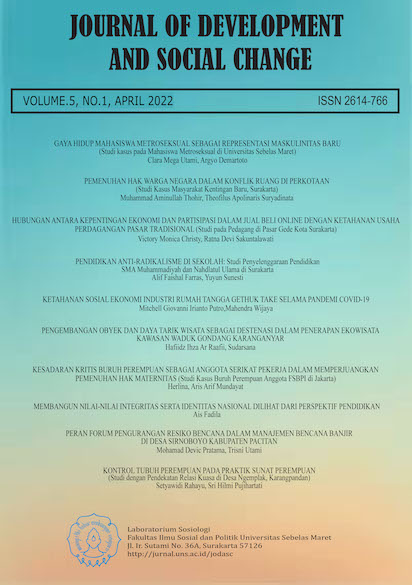RISIKO DAN REFLEKSIVITAS GAY TERHADAP KEKERASAN (Studi Kasus pada Komunitas Gay di Surakarta)
Abstract
Gay is a minority group the existence of which is still unacceptable to the society. It puts the gay into a group vulnerable to violence risk. The objective of research is to study the risk and the reflexivity of violence in gay community in Surakarta. This qualitative with case study approach took place in Surakarta. The sampling technique used was purposive sampling one. The informant of research consisted of chairperson and administrators of Surakarta Gaya Mahardhika Foundation, gays becoming the victim of violence, community fellow members, and administrators of Mitra Alam Surakarta NGO. Data was collected through observation, in-depth interview, and documentation. To validate data, source triangulation was used. Technique of analyzing data used was Miles and Huberman’s interactive model of analysis with Ulrich Beck’s Risk Society theory.
The result of research showed that violence risk encountered by gay in Surakarta included physical violence such as being thrown with sharp weapon, being struck and slapped; physical/emotional violence such as cynical and disliking view, expulsion, threat and negative stigma intended to gay organization; sexual violence such as sexual abuse conducted by police officer by touching the victim’s body organ; economic violence such as money and product expropriation by sexual partner; and verbal violence such as being insulted and mocked by some people on the street. The effect of violence consisted of physical effect such as bruise, gash, and pain still felt until today, and physical effect such as fear, trauma, discomfort and fidget, disappointment, resentfulness, anger, pique, and regret. The reflectivity of gay in dealing with violence included interacting or looking for acquaintance or partner more alertly and selectively; adapting, comporting; building intimacy an self-image by conducting positive activities within society; conducting homosexual activity more carefully such as fulfilling their sexual need in their known place rather than doing it in opened space that has been known by mass organization; and providing advocacy to the gay becoming the victim of violence.
References
Adams, H.E.; Wright, L.W.; & Lohr, B. A. (1996). Is Homophobia Associated WithHomosexual Arousal? Journal of Abnormal Psychology.
Allgeier, E.R & Allgeier, A.R. (1991). Sexual Interacions (Third edition). Lexington: D.C. Healt and Company.
Apriliani, P; Santosa, B. (2018). Pemanfaatan Media Sosial dalam Relasi Sexual Kaum Gay. Journal of Development and Social Change, 1 (2).
Beck, Ulrich. (1992). Risk Society : Towards a New Modernity. London: Sage Publications.
Dank, M. (2013). Dating Violence Experiences of Lesbian, Gay, Bisexual, and Transgender Youth. Journal of Youth and Adolescence, Volume 43, Issue 5 , 846–857.
Demartoto, A. (2010). Mengerti, Memahami Dan Menerima Fenomena Homoseksual. Materi Dosen Jurusan Sosiologi FISIP UNS . Dipetik Oktober 24, 2018, dari http://argyo.staff.uns.ac.id/files/2010/08/seksualitas-undip.pdf
____________(2013).Teori Masyarakat Risiko dari Ulrich Beck. Materi Dosen Jurusan Sosiologi FISIP UNS. Dipetik dari http://argyo.staff.uns.ac.id/2013/03/14/teori-masyarakat-risiko-dari-ulrich-beck/
Harianjogja.com. (2016). Kaum Gay di Solo Diklaim Capai 5.000 Orang. Dipetik Maret 2, 2018, dari http://www.harianjogja.com/baca/2016/02/20/fenomena-lgbt-kaum-gay-di-solo-diklaim-capai-5-000-orang-693281
Kartono, Kartini. (1989). Psikologi Abnormal dan Abnormalitas Seksual. Bandung: PT. Mandar Maju.
Levy, Brian L. (2017). When love meets hate: The relationship between state policies on gay and lesbian rights and hate crime incidence. Social Science Research, Volume 61 , 142-159.
Messerschmidt, J. W. (2012). Gender, Heterosexuality, and Youth Violence: The Struggle for Recognition. Maryland: Rowman & Littlefield Publishers, Inc.
Oetomo, Dede. (2001). Memberi Suara Pada Yang Bisu. Yogyakarta: Galang Press.
Putri, R. R. (2012). Kekerasan Dalam Berpacaran. Skripsi Fakultas Psikologi Universitas Muhammadiyah Surakarta.
Sindhunata. (2000). Menuju Masyarakat Risiko. Jurnal Basis, Januari-Februari 2000, No. 01-02, Tahun ke 49.
Tempo.co. (2016). 89,3 Persen LGBT di Indonesia Pernah Alami Kekerasan. Dipetik Oktober 3, 2018, dari nasional.tempo.co: https://nasional.tempo.co/read/739961/893-persen-lgbt-di-indonesia-pernah-alami-kekerasan
Wahyuni, S. (2012). Kekerasan pada Gay di Surakarta : Bentuk dan Usaha-usaha Gay dalam Menghadapinya. Skrispi Jurusan Sosiologi FISIP Universitas Sebelas Maret Surakarta.
Woodford, M.R. (2014). Discrimination and Mental Health Among Sexual Minority College Students: The Type and Form of Discrimination Does Matter. Journal of Gay & Lesbian Mental Health , 142–163.
DOI: https://doi.org/10.20961/jodasc.v2i2.41666
Refbacks
- There are currently no refbacks.




